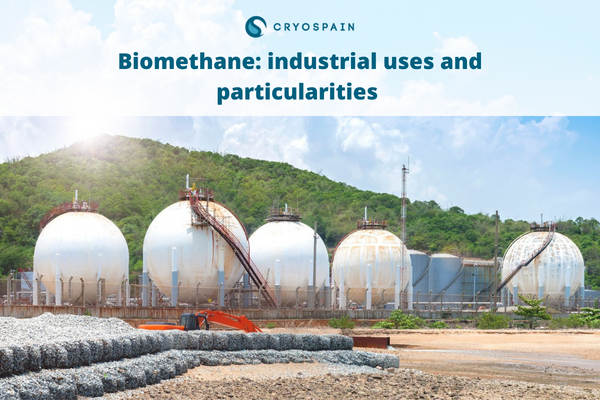As the different industries race to find sustainable yet efficient energy sources, biomethane stands out as one of the most interesting alternatives.
Find out what is biomethane exactly, what are the differences between it and biogas, and the right equipment to handle liquid biomethane.
What is biomethane?
Biomethane results from processing biomass to obtain methane
Also known as renewable natural gas (RNG) or Sustainable Natural Gas (SNG), it presents similarities to natural gas but is considered a renewable source, as it can be endlessly obtained from organic matter in the process known as bio methanation.
Biogas and biomethane: what’s the difference?
Simply put, biomethane is an upgraded form of biogas, generated through the anaerobic digestion process.
On one hand, bacteria break down organic matter at solid waste landfills to produce biogas. The result is a mixture of gasses that may contain between 40 or 70% methane and other compounds (30–40 % CO2, 2–8 % of H2O and other compounds and particulates). Other potential sources for biogas include sludge from wastewater plants, livestock waste and arable waste, among others.
On the other hand, upgrading biogas produces biomethane, which helps remove carbon dioxide, water vapors, and other compounds.
The result is a compound where the methane proporcion is higher, typically similar to natural gas of fossil origin.

Production pathways for biomethane
Today, the main technique to obtain biomethane is the upgrading of biogas. There are a number of potential pathways in order to do so:
- Water washing
- Chemical absorption
- Pressure swing adsorption (PSA)
- Membrane separation
- Cryogenic technologies
Additionally, some operators are experimenting with a second pathway for obtaining biomethane, which includes the thermal gasification of solid biomass, which is then put through bio methanation processes. In this case, high temperatures and pressure are used in low-oxygen environments so that biomass is broken down into a mixture of gasses. Then, a reaction is produced to produce methane, while other undesired compounds are eliminated.
How is biomethane stored?
Achieving an efficient storage and transportation of this gas has been crucial for industries looking to make the most of this renewable source of energy.
Today, many consider converting biomethane into liquid biomethane (LBM) as one of the most optimized methods for storing it.
Read also: Photovoltaic power station: greener energy for Cryospain
This process facilitates long-term storage and transportation for two main reasons:
- Liquid biomethane presents a lower volume, so that larger quantities can be stored in less space compared to the gaseous form of biomethane. In other words, it helps save space. Super-insulated cryogenic vessels are used for this purpose.
- You can transport it using for cryogenic substances, following similar processes as transporting Liquefied Natural Gas (LNG).
- Super-insulated pipe systems can also be adopted for the transportation of liquid biomethane between two cold points.

Industrial applications of biomethane
This gas is becoming a key source of energy as private and public organizations endorse the search for more sustainable alternatives.It transforms into electricity and heat more efficiently than biogas.
It thus facilitates a number of alternatives and industrial applications:
- Transportation fuel replaces compressed natural gas, diesel, and liquid natural gas (specifications for this process can be found in UNE-EN 16723-2).
- Generation of steam and heat
- Combined heat and power production
- Injection into the natural gas grid. In this case, you must observe certain requirements, which UNE-EN 16723-1 includes.
Keep reading: The value of technical gases for industrial production
Benefits of biomethane
Cut down on harmful emissions
Biomethane represents a more environmentally-friendly alternative source of energy as it minimizes CO2 emissions on several fronts.
Firstly, it aids in controlling emissions generated naturally from organic residues, which subsequently release into the atmosphere. Secondly, it facilitates a transition away from fossil fuels utilized as energy sources. Finally, its production contributes to restoring organic carbon back into the soil, thereby enabling the avoidance of other less sustainable fertilizers.
Reduce dependency on importing fossil fuels
Today, many countries are dependent on importing fossil fuels that are not immediately available to them. Biomethane can provide significant relief in this area.
The European Biogas Association paints a clear picture on the importance of biomethane regarding the building of less dependent economies when it comes to fossil fuels. In a 2021 report, they cited how the European Union was 90% dependent on imported fossil gas. However, European biomethane production could be able to reach 24% of natural gas consumption in the EU.
Visit our blog for more news
Develop circular economies and sustainable agriculture
As biomethane is generated from organic residues, its production relies on turning what is considered as waste into a valuable resource.
Additionally, biomethane gas can also provide the means towards developing a more sustainable agriculture model. As such, it helps managing waste and residues, while also improving soil quality. A healthier ecosystem produces carbon sinks and controls and minimizes methane emissions from livestock.

Biomethane market growth
The advantages outlined above provide several reasons why the biomethane market is experiencing continuous growth.
Increased possibilities for the storage and transport of liquid biomethane, as well as growing encouragements from public policies in several territories are also two main reasons for this market’s expansion.
Figures for this growth are provided by several market research and intelligence agencies. For instance, Transparency Market Research quantifies the global biomethane market to grow at a CAGR of 6.9% from 2021 to 2031, meaning the market could expand from US$ 1.9 Bn in 2020 to 4 Bn by 2031.
Today, the main territories pushing for biomethane include the United States, Europe and The People’s Republic of China, accounting for 90% of production around the globe.
UNE-EN 16723-1 regulating the use of biomethane
As the use of biomethane expands across the globe, the need for unified standards emerge. It’s in this context that the standard UNE-EN 16723 (Natural gas and biomethane for use in transport and biomethane for injection in the natural gas network) has been born.
Additionally, the standard divides into two parts:
- Part 1: UNE-EN 16723-1: Specifications for biomethane for injection in the natural gas network
- Part 2: UNE-EN 16723-2: Automotive fuels specification
Get in touch with us and discover Cryospain’s project management consulting services for cryogenic engineering.









